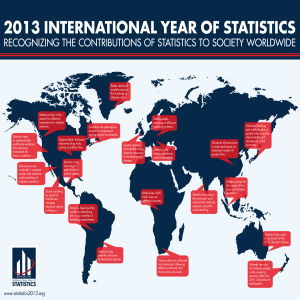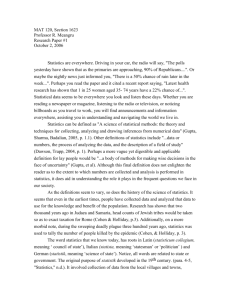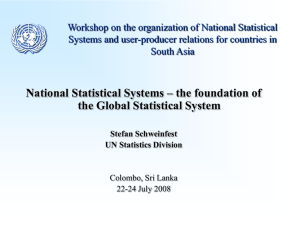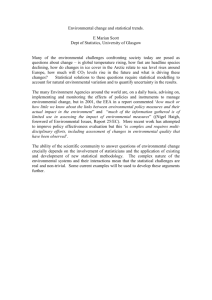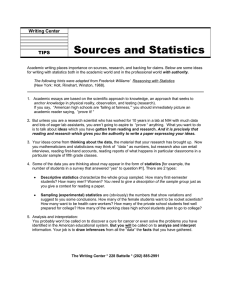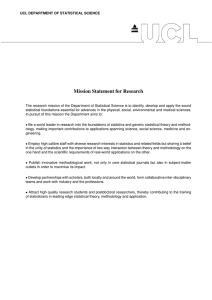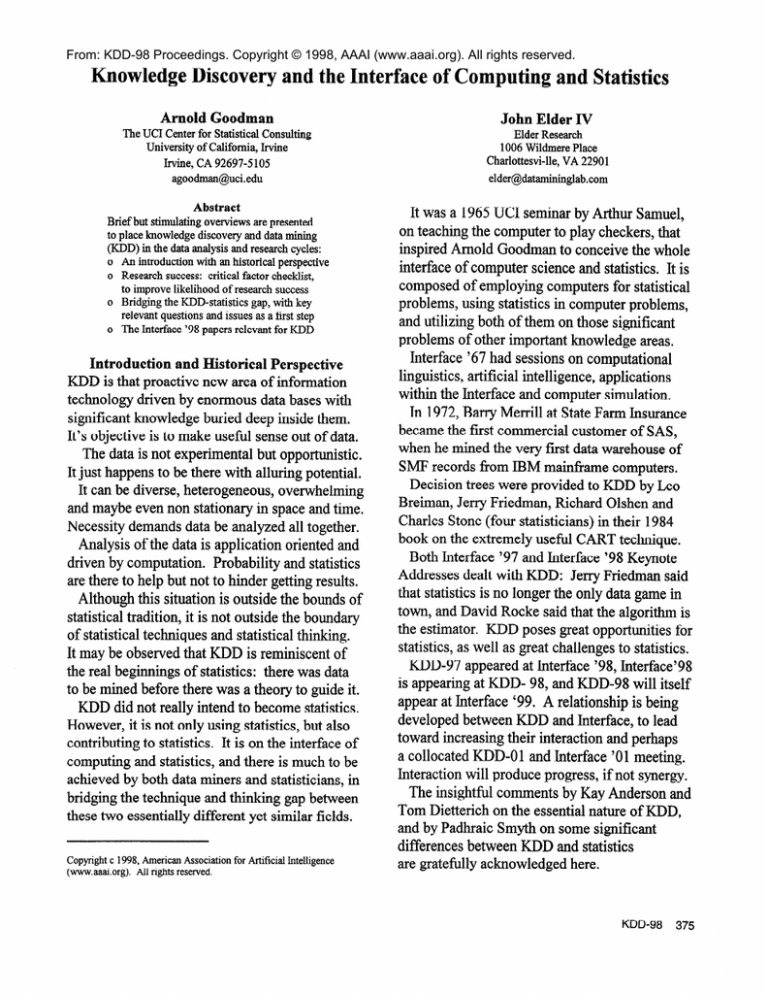
From: KDD-98 Proceedings. Copyright © 1998, AAAI (www.aaai.org). All rights reserved.
Knowledge Discovery and the Interface of Computing and Statistics
John Elder IV
Arnold Goodman
The UC1 Centerfor StatisticalConsulting
University of California, Irvine
Irvine, CA 92697-5105
agoodman@uci.edu
Abstract
Brief but stimulatingoverviewsarepresented
to place knowledgediscoveryand datamining
(KDD) in the data analysisand researchcycles:
o An introduction with an historical perspective
o Researchsuccess:critical factor checklist,
to improvelikelihood of researchsuccess
o Bridging the KDD-statisticsgap, with key
relevantquestionsand issuesas a first step
o The Interface‘98 papersrelevantfor KDD
Introduction and Historical Perspective
KDD is that proactive new area of information
technology driven by enormous data baseswith
significant knowledge buried deep inside them.
It’s objective is to make usetil senseout of data.
The data is not experimental but opportunistic.
It just happensto be there with alluring potential.
It can be diverse, heterogeneous,overwhelming
and maybe even non stationary in spaceand time.
Necessity demandsdata be analyzed all together.
Analysis of the data is application oriented and
driven by computation. Probability and statistics
are there to help but not to hinder getting results.
Although this situation is outside the bounds of
statistical tradition, it is not outside the boundary
of statistical techniques and statistical thinking.
It may be observed that KDD is reminiscent of
the real beginnings of statistics: there was data
to be mined before there was a theory to guide it.
KDD did not really intend to become statistics.
However, it is not only using statistics, but also
contributing to statistics. It is on the interface of
computing and statistics, and there is much to be
achieved by both data miners and statisticians, in
bridging the technique and thinking gap between
these two essentially different yet similar fields.
Copyright c 1998, American Association
for Artificial
(www.aaai.org). All rights reserved.
Intelligence
Elder Research
1006 WildmerePlace
Charlottesvi-lle,VA 22901
elder@datamininglab.com
It was a 1965 UC1 seminar by Arthur Samuel,
on teaching the computer to play checkers, that
inspired Arnold Goodman to conceive the whole
interface of computer science and statistics. It is
composed of employing computers for statistical
problems, using statistics in computer problems,
and utilizing both of them on those significant
problems of other important knowledge areas.
Interface ‘67 had sessionson computational
linguistics, artificial intelligence, applications
within the Interface and computer simulation.
In 1972, Barry Merrill at State Farm Insurance
becamethe first commercial customer of SAS,
when he mined the very fust data warehouse of
SMF records from IBM mainf?ame computers.
Decision trees were provided to KDD by Leo
Breiman, Jerry Friedman, Richard Olshen and
Charles Stone (four statisticians) in their 1984
book on the extremely usetil CART technique.
Both Interface ‘97 and Interface ‘98 Keynote
Addresses dealt with KDD: Jerry Friedman said
that statistics is no longer the only data game in
town, and David Rocke said that the algorithm is
the estimator. KDD poses great opportunities for
statistics, as well as great challengesto statistics.
KDD-97 appearedat Interface ‘98, Interface’98
is appearing at KDD- 98, and KDD-98 will itself
appear at Interface ‘99. A relationship is being
developed between KDD and Interface, to lead
toward increasing their interaction and perhaps
a collocated KDD-0 1 and Interface ‘0 1 meeting.
Interaction will produce progress, if not synergy.
The insighttil comments by Kay Anderson and
Tom Dietterich on the essential nature of KDD,
and by Padhraic Smyth on some significant
differences between ISDD and statistics
are gratefully acknowledged here.
KID-98
375
Research Success: Critical Factor Checklist
Extend inferences to plans, evaluations & values.
How Checklist Works. The summary comments:
.OOWeight factors according to their importance
.OOAdd weights of those factors accomplished
.OOGive a partial weight for a portion done
.OOScore might simulate a “probability”
Where to Start. Weights for factors:
.Ol Constraints from data collection
.O1 Preprocessingor transformations
.O1 Prioritized information objectives
.Ol What is to be included & what not
.Ol Where to learn & where to validate
How to Start. Weights for factors:
.02 Data questions
.02 Problem needs
.02 Prior knowledge
.02 Problem structure
.02 Meaningful models
.02 Applicable methods
.02 Useful visualizations
.02 Experimental designs
When to Stop. Weights for factors:
.02 Iteration stability
.02 Result consistency
.02 Data support excess
.02 Problem requirements
.02 Learning validation tips
.02 Maybe sequential analysis
What to Infer. Weights for factors:
.03 Clusters & regions
.03 Distributions & trees
.03 Relationships & models
.03 Comparisons & contrasts
.03 Indications of any changes
What to Do Next. Weights for factors:
.03 Posing questions & issues to resolve
.03 Using different techniques on the data
.03 Using the techniques on different data
.03 Developing the meaning for inferences
.03 Presenting the inferences to customers
.03 Generating added methods & theory
What to Evaluate. Weights for factors:
.02 Assumption/data accuracy & compatibility
.02 Size variations & strength of relationships
376
Goodman
.02 Truth & meaningfulness of all inferences
.02 Consistency & sensitivity of inferences
.02 Importance vs statistical significance
.02 Confirmation or criticism of model
.02 “Distance” of inferences from data
.02 Client’s understanding of inferences
.02 Use of inferences in problem context
.02 Quality vs timeliness of the inferences
.02 Cost-effectiveness of existing inferences
.02 Cost-effectivenessof additional inferences
What the Objective Is. Weights for factors:
.O1 Objective was data mining
.Ol Objective was data refining
.O1 Objective was data defining
.Ol This influences when to stop
.Ol This influences what to infer
.Ol This influences what to do next
.Ol This influences how to evaluate
What Resulting Value Is. Weights for factors:
.Ol To expense,income & competitive position
.Ol To quality, time & customer service
.Ol To understanding & advances
Bridging the KDD-Statistics Gap
Data Stages. The key questions & issues follow.
o What can statisticians contribute to progress
without detracting from required efficiency?
o What are the most important & pressing data
mining issues statisticians can contribute to?
o What & how can data miners contribute to
the data stages& to statistics in particular?
o What & how can statisticians contribute to
the data stages& to data mining explicitly?
o Think about having statisticians evaluate the
statistical consequencesof KDD software.
o Think about developing e-mail lists of those
statisticians desiring to collaborate on KDD.
o Think about developing e-mail lists of data
miners desiring to collaborate on statistics.
o Think about all the data mining, data refining
& data defining stageswhile in every stage.
o Think about the requirements for transition
from current stage to the following stage(s).
o Act appropriately for the current stage,but
not to detriment of the following stage(s).
Key questions & issues follow.
o What can statisticians contribute to efficiency
without detracting from the effectiveness?
o Think about getting ready & aiming to fire
before firing without getting ready or aiming.
o Think about capitalizing on the estimates&
testing researchbefore variation searching.
o Think about happening often & happening
almost always before believe happening once.
o Think about targeting later correlations &
relationships before targeting coincidences.
o Think about the required symbolism & its
terminology before being buried in acronyms.
Data Refining. Key questions & issuesfollow.
o How can both data miners & statisticians
cooperateto transition beyond data mining?
o Think to explore with vigor & explain with
rigor before exploiting with too much zeal.
o Think about desired information & desired
knowledge before finding desired meaning.
o Think about technology engine & science
engine before utilizing mathematics engine.
0 Think interesting/informative & insightful/
institutional prior to indicative/ingenious.
Data Defining. Key questions & issuesfollow.
o What can data miners contribute to being
better without detracting from productivity?
o Think about reducing results & generalizing
implications before understanding methods.
o Think about bringing size under control &
process conclusions before truth of a theory.
o Think about seeking change & utilizing
change before just assessingthe change.
o Think about the needed flexibility &
synthesisbefore letting discipline reign.
o Think about preceding pictures & formulas
before relying on merely concepts &jargon.
Research Stages. Some key issues follow.
o Think about all of the research stages& their
characteristicswhile operating in every stage.
o Think about the requirements for a transition
from current stageto the following stage(s).
o Act appropriately for the current stage,but
not to the detriment of the following stage(s).
Where to Start. Some key issues follow.
Data Mining.
o Think about what statisticians might actually
contribute to information objectives priority.
o Think about what statisticians might actually
contribute to where learn & where validate.
How to Start. Some key issues follow.
o Think about what statisticians might actually
contribute to building a problem’s structure.
o Think about what statisticians might actually
contribute to considering experiment designs.
When to Stop. Some key issues follow.
o Think about what statisticians might actually
contribute to analysis not exceeding support.
o Think about what statisticians might actually
contribute to utilizing sequential analysis.
What to Infer. Some key issuesfollow.
o Think about what statisticians might actually
contribute to relationship & model inference.
o Think about what statisticians might actually
contribute to indications of change inference.
What to Do Next. Some key issuesfollow.
o Think about what statisticians might actually
contribute to use different techniques on data.
o Think about what statisticians might actually
contribute to developing inference meaning.
What to Evaluate. Some key issues follow.
o Think about what statisticians might actually
contribute to inference truth/meaningfulness.
o Think about what statisticians might actually
contribute to seeing result distance from data.
What Resulting Value Is. Key issuesfollow.
o What techniques can statisticians introduce to
clarify, expedite & guide valuation process?
o Think about what statisticians might actually
contribute to find the thinking & techniques
for identifying value when it is visible & for
developing value when it is not easily visible.
Interface ‘98 Papers Relevant for KDD
Internet-measurementpapers are:
o Vem Paxson, “Statistical Challenges in
Analyzing the Internet” -- pooling diverse &
heterogeneousdata to fmd islands of stability
o John Quarterman, ‘Visualization of Internet
Data” -- using geographical maps & graphs to
measureintemet quality of service from data
How to Start.
KDD-98
377
o Walter Willinger, “Finding Order within
Chaos”-- using wavelets to identify & detect
scaling properties in nonstationary space/time
When to Stop. Tree-based methods papers are:
o David Banks, “Maximum Entropy Models
for Graph-Valued Random Variables” -model selection to reflect application metrics
o Hugh Chipman, Edward George & Robert
McCulloch, “Making Senseof a Forest of
Trees” -- metrics to see archetypes& clusters
o William Shannon, “Averaging Classification
Tree Models” -- using maximum likelihood
& consensusestimates of “mean & variance”
What to Infer. Software technology papers are:
o R. Douglas Martin & Michael Sannella, “An
Iconic Programming Interface for S-Plus and
Mathcad” -- using component technology to
integrate data & computing across packages
o David Wishart, “Exploiting the Graphical
User Interface in Statistical Software: The
Next Generation”-- with filtering, wizards,
tutoring, visuals, model design, multiple
windows, what-ifs & intemet linkages
o David Woodruff, “Heuristic Search
Algorithms: Applications in & of Statistics”
-- for combinatorial analysis in multivariate
problem robustness & cluster analysis
The four distribution & five tree papers are:
David Marchette & Carey Priebe,
“Alternating Kernel and Mixture Density
Estimation” -- a semi-parametric approach
Michael Minnotte, ‘Higher Order
Histosplines: New Directions in Bin
Smoothing” -- an extension to multivariate,
nonparametric & boundary effect applications
David Scott, “On Fitting and Adapting of
Density Estimates” -- using moments of bins
& polynomial patches for kernel estimates
Sung Ahn & Edward Wegman, “A Penalty
Function Method for Simplifying Adaptive
Mixtures Density Estimates” -- reducesthe
complexity for mixtures of normal densities
Andreas Buja & Yung-Seop Lee, “Criteria for
Growing Classification and Regression
378
Goodman
Trees” -- better interpretation by splitting data
based on the better performing of subsamples
Steven Ellis, Christine Watemaux, Xinhua
Liu & J. John Mann, ‘Comparison of
Classification and Regression Trees in S-Plus
and CART” -- CART has tree evaluation,
error estimation & subsampling while S-Plus
has better computing, graphics & interpreting
Douglas Hawkins & Bret Musser, “One Tree
or a Forest? Alternative Dendrographic
Models” -- comparing trees plus their
generating rules via membership & metrics
Padraic Neville, “Growing Trees for Naive
Bayes and Score Card Models” -- title says it
S. Stanley Young & Andrew Rusinko III,
“Data Mining of Large High Throughput
Screening Data Sets”-- extending recursive
partitioning, for relating chemical structure to
biological activity, for many-many variables
The six relationship & model papers are:
Julian Faraway, “Data Splitting Strategiesfor
Assessing Model Selection Effects on
Inference” -- performance is no better than
using all the data for selection & inference
Hakbae Lee, “Exploring Binary Response
Regression Based on Dimension Reduction”
-- sliced inverse regression, sliced average
variance estimation & covariance differences
Wei Pan, “Bias/Variance Tradeoff in
Combining SubsampleEstimates for a Very
Large Data Set” -- the title essentially says it
Armin Roehrl, “Fast, Portable, Predictable
and Scalable Bootstrapping” -- using bulk
synchronousparallel computing to bootstrap
Terry Themeau, “Penalized Cox Model in
S-Plus”-- with smoothing splines & frailty
Jimmy Ye, “On Measuring and Correcting
the Effects of Data Mining and Model
Selection” -- generalized degreesof freedom
framework for comparing the “costs” of
alternative modeling & mining techniques
Reference. Weisberg, S. ed. 1999. Proceedings
of Interface ‘98: 30th Symposiumon the Interface of Computing and Statistics. Forthcoming.

